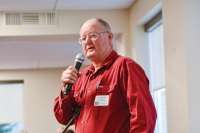GOP may loosen rules on lottery proceeds
With the GOP takeover of the state General Assembly, lottery money and how schools use what they’re given will come under new scrutiny.
“I wouldn’t have voted for a lottery, but it is the law now and it needs to be done properly,” said Jim Davis, an incoming freshman Republican senator from Franklin.
Davis unseated Democratic incumbent Sen. John Snow in November, helping Republicans — for the first time in more than a century — take control of the House and Senate.
“I think the research will show the poor counties have a higher per-capita lottery purchase, and those people can’t afford (to play the lottery),” Davis said. “But it is here now.”
Davis, a former longtime Macon County commissioner, is an unwavering, unapologetic supporter of local control. Though Davis said he finds Haywood County’s decision to use lottery money for football stadium upgrades difficult to rationalize, “if the school board wants to do that and commissioners OK the choice, they ought to be able to do that.”
Incoming state senator Ralph Hise, R-Spruce Pine, said he would support allowing schools to use their lottery funding for items other than capital improvements again this year.
“I wouldn’t just limit that to lottery funding,” Hise said. “I think that we have to give local school boards more options in using their funding. We know the level of cuts, and as we get more specific information, we hope to be able to give as much flexibility to state departments and others with their own budgets.”
That would be a welcome change to Macon County Schools Superintendent Dan Brigman.
“I would love to have more lottery dollars,” Brigman said. “The formula definitely needs to be revised.”
Money from the North Carolina Education Lottery is divided among school districts based on enrollment. Counties with a higher tax rate used to get a higher percentage of lottery money, meaning Western North Carolina with its historically low tax rate got penalized. That was changed by the General Assembly two years ago.
— By Quintin Ellison and Colby Dunn
Haywood schools chart course for future
This fall, while Haywood County students are focused on homework, football, the opposite sex and the many other preoccupations of youth, their teachers and administrators are mapping a plan to make them more successful and competitive when they leave Haywood’s hallowed halls of learning.
2010 is a year for Long Range Strategic Planning in the school system, and if you gave only a cursory glance to the state of schools in North Carolina, you’d think they have their work cut out for them.
Haywood County Schools alone have seen $5.2 million in funding cuts since January 2009. Instead of increasing teacher assistants as planned, they are losing them left, right and center to lack of funding, struggling to keep hold of the 68 that remain. Meanwhile, the economy outside the school budget has worsened as well, and more than half of Haywood County students are now eligible for free or reduced lunch, a measure the school uses to gauge poverty levels among its students.
But Assistant Superintendent Bill Nolte said he doesn’t look at it like that. He knows that the increase in poverty and need among students and the decrease in funding is — and will continue to be — a challenge.
“We know our population is changing,” Nolte said “We know that our free and reduced lunch rate has changed about 10 percent in the last 11 years.”
But he’s also optimistic that the changes that have happened since the last long-range planning sessions in 2005 have not all been for the worse.
“The world really is different,” Nolte said. “I mean we’re changing at a very rapid rate. It’s just amazing. When these recommendations were made (in 2005) I had dialup at my house and could not get cable. I hope the (new) recommendations are different, because we don’t want recommendations for 2010, we want people to think about ‘OK, what’s it going to be like in 15 years or 17 years and what should we be striving for?’”
To do that, Nolte and his team have identified five areas they want to plan for, and then called on the community to help them map out the steps to get there in the long term.
The school system asked anyone who was interested — parents, community leaders, business people and just interested residents — to volunteer for committees that would spend anywhere from weeks to months suggesting what they think schools and students need to be doing in the future.
They try to stay within the state objectives and keep the school’s mission statement in mind, but Nolte said school administrators try to give the committees free-rein in dreaming up their recommendations, hoping to stir up innovation and creative thinking that wouldn’t happen under strictly-imposed guidelines.
But Knox Hardin, the school system’s testing director and co-chair of the committee tasked with producing globally competitive students, said that the state of affairs in the county, state and nation has put something of a damper on how far recommendations can go.
“Five years ago, we were not in the economic situation that we’re in now,” said Hardin, who co-chaired a similar committee during the 2005 planning process. “We have been asked to try and at least give half of our recommendations that we make that would not be dependent on funding. Five years ago, we could look pie-in-the-sky.”
Besides wholesale changes in the economy and the system’s funding base, this year’s plan will likely be vastly different from 2005 because the school system itself is moving in a new direction. Just over two years ago, the system adopted a new mission that places passion and productivity at the heart of all they do. And Nolte hopes that the committees will keep this in focus when they’re looking into the future.
“One of the things we talk to (the committees) about is as you’re developing recommendations, please remember our missions,” said Nolte. “Is this something we would fight for, lobby for, advocate for, spend for? Is it a productive way to do it? Does it promote student success in some objective measure that we have for students?”
Looking back at the 2005 recommendations, some did clearly fit those criteria. Out of 20 recommendations that the school system adopted, it only fully achieved nine, which included a major reduction in dropout rates, gym remodels at both Pisgah and Tuscola high schools, and beefing up technology education, both in quantity and quality.
Two of the recommendations — increase teacher assistants in grade K-3 and build an additional middle school — weren’t met at all. In fact, they actually lost teacher assistants and are struggling to keep the ones they have, although Nolte said this is simply a matter of money, or the lack of it.
Of the other nine goals, all were met partially, but to varying degrees. Some, like activity bus replacement, were halted with the budget drop. Others, such as computer, router and server replacement have been nearly met, with a good computer replacement cycle in place with only a lag in server replacement.
Still others, however, were sort-of met but lack a good bit before they could credibly be called successful. For example, the directive to provide staff development focusing on the Spanish-speaking population included only one summer “staff development” and a 30-minute refresher course, with a few “scheduled meetings” tacked on for good measure.
Hardin said that now, when the committees meet, they look back at these, assessing where they succeeded, where they failed and what failures should be tackled again.
“The ideal goal is to come up with suggestions that can help improve academic performance and have future-ready graduates that are ready to go into the workplace or ready to go into the next step beyond high school,” Hardin said. “We need to have our kids prepared to do the best at whatever they do when they leave school.”
Nolte echoes this sentiment, saying that he hopes the plan will provide a path towards making all of Haywood County’s schools better in what may continue to be very tough times.
“The recommendations are a real, tangible guiding beacon. They give real direction to your decision making,” said Nolte. “We really do believe that everything’s important. We really do believe that you’re not a great school system if you only do one or two things well and other things are really crummy.”
WNC schools hooked up with fiber
Thanks to a collaborative project called WNC EdNet, high-speed Internet will become a reality for all public and charter school classrooms in Cherokee, Clay, Graham, Jackson, Macon and Swain Counties, along with the Qualla Boundary.
WNC EdNet recently got the go-ahead to connect The Highlands School — the last remaining school to join the regional network.
As late as 2000, schools in Western North Carolina could only transmit 1.5 megabyte per second. Now, schools with fiber can enjoy 100 megabyte per second connections.
Once these high-speed connections are in place, star pupils from far-flung schools can join together in a virtual classroom to take advanced courses that aren’t normally offered at their own schools. Live video will allow for face-to-face interaction between students and teachers.
“It’s not like an online class,” said David Hubbs, CEO of BalsamWest FiberNET, which implemented the WNC EdNet project. “You’re speaking to or interacting with a teacher in real time.”
Linking up to the state network creates access to The North Carolina Virtual Public High School, which already offers 72 courses including Advanced Placement and world language classes.
The widespread reach of fiber across North Carolina to even the most rural schools holds the promise of creating a level playing field for students, according to Bob Byrd WNC EdNet project manager.
“That’s our big push now, to narrow that digital divide,” said Byrd.
Moreover, fiberoptic technology makes professional training more readily available for teachers. Once colleges are hooked up to the statewide K-12 network, student-teachers at Western Carolina University or other colleges may observe teachers in actual classrooms without interrupting lessons.
Being on the same fiber network also decreases overhead for school systems, which only have to pay one Internet bill for all their schools, Hubbs said.
Jumping hurdles
The WNC EdNet project has traveled down a long road to get to where it is now.
Nearly 60 schools have been hooked up to their central office in the county via a fiberoptic line, which makes broadband Internet possible and also provides an important backbone for communication between the school district office and individual schools.
A separate project by a nonprofit called MCNC is in turn connecting these school district offices to a statewide fiber network, the North Carolina Research and Education Network. Now, MCNC is also working on linking colleges up to the state network.
WNCEdNet piggybacked onto the larger BalsamWest project, which has installed hundreds of miles of fiber underground to promote economic development in the Western North Carolina.
The mountainous terrain was a major obstacle BalsamWest had to overcome while installing equipment underground.
“The very things that we love about our rural area create challenges for technology,” said Hubbs.
Constructing in the remote area between Cashiers and Highlands was another challenge. BalsamWest had to speak individually to every property owner to get permission to build.
“We had more private easements between Cashiers and Highlands than we did everything else put together, over 300 miles,” said Hubbs. About 15 grant applications had to be submitted to lock down funding for the $6.1 million WNC EdNet project. The project was partly funded by the Golden LEAF Foundation, which chipped in $2.2 million, and the Cherokee Preservation Foundation, which contributed $1.7 million.
Even with 12 different partners — including Southwestern NC Planning & Economic Development Commission, the Western Region Education Service Alliance, seven school districts and three colleges — WNC EdNet was smoothly coordinated.
A similar project in eastern North Carolina had failed due to infighting, according to Leonard Winchester, chairman of the WNC EdNet technology committee.
WNC EdNet coordinators were asked to come to Raleigh and explain how their particular project ended in success. Winchester said cooperation was key.
“We had a group of people that trusted each other,” said Winchester. “That trust, you can’t give to somebody else.”
Reality, outcomes and education spending
This deserves emphasis, given the central role that public education plays in North Carolina political debate: our schools have vastly more resources to work with than they did a generation ago.
Affordable college is available
By Bill Rhodarmer
I read with interest a recent column in a local news publication concerning the high cost of a college education and the debt often incurred by students and families — up to $50,000 for a four-year degree. In the column, the editor indicated that the only way to lessen the high cost and associated debt was for the state and federal governments to become more involved in controlling costs and providing more student aid.
The test, and nothing but the test
I don’t bash public schools. My wife’s a teacher, my children have gotten a great education at these schools, and we’ve been able to solve every major problem that ever arose with a teacher.
Celebrating 10 years as an A+ school
By Michael Beadle
Central Elementary School capped its 10-year anniversary as an A+ school Friday, May 19, with students, parents, county leaders, school officials and school alumni joining in the celebration.
Learning the language
By Michael Beadle
When Lori McLeod first started teaching English as a Second Language at Tuscola High School in Haywood County, she had two students. They didn’t constitute enough to make a class, so she would pull them out of classes for tutoring.
Jackson candidates weigh in on education issues
By Sarah Kucharski • Staff Writer
They’ve said they want to strengthen the economy. They’ve said they want to help bring in higher paying jobs. They agree that doing it will require local schoolchildren to get the best education possible.
Changing budget laws would save taxpayer money
The words still ring in my ears, coming as they did from a teacher who had spent years playing by the book: “I’ve got to spend the money by the end of the school year or it’s gone, so I’m gonna spend it on something.”









